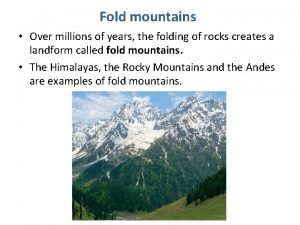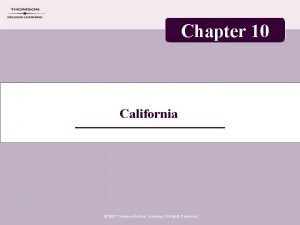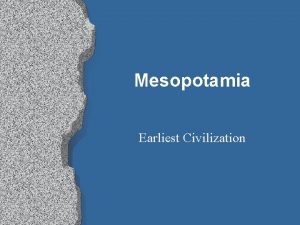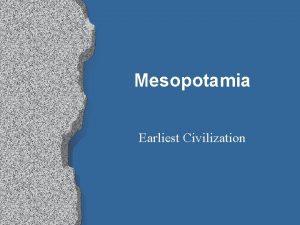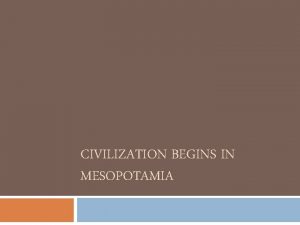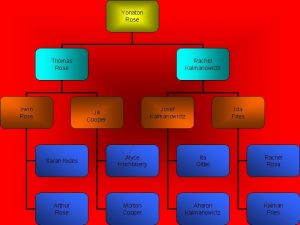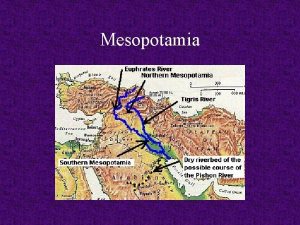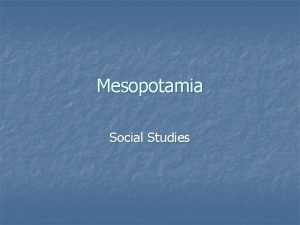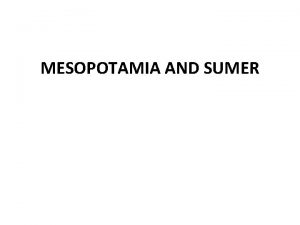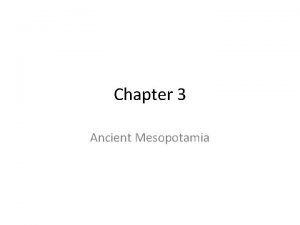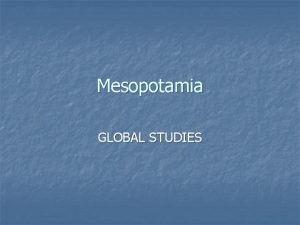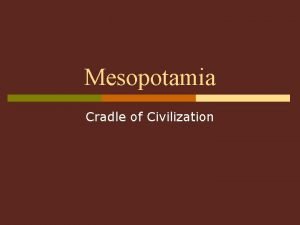Mesopotamia Mesopotamia This civilization rose in the valleys

















- Slides: 17

Mesopotamia

Mesopotamia This civilization rose in the valleys between the Tigris and Euphrates rivers. This civilization arose around 3500 B. C. E.

Politics and conflicts • The area surrounding Mesopotamia and the Fertile Crescent is dry but there are no strong natural boundaries to keep out invaders. • Therefore, the history of Mesopotamia and the Fertile Crescent is one of conflict and war, with many groups of people trying to invade or hold on to this valuable land.

Civilizations of the Fertile Crescent & Mesopotamia • The various civilizations that occupied part of the Fertile Crescent or Mesopotamia in ancient times include; the Sumerians the Persians the Akkadians the Babylonians the Phoenicians the Hebrews the Assyrians

Politics

The first kingdom of Mesopotamia was the Sumerians. Different groups would conquer their predecessors and install their own kingdom and political system. They also made different contributions to society. One contribution of the Sumerians was the invention of the wheel.

Politics cont. • In about 2000 B. C. , the Babylonian empire was established in Mesopotamia by the Amorites. • The Babylonian empire reached its peak during the reign of Hammurabi (1792 – 1750 B. C. ) • Hammurabi’s legacy is the code of laws he had created. • Called Hammurabi’s Code of Laws, this is the first known written law code.

Hammurabi’s code cont. • The code lists 282 specific laws dealing with family, business conduct, and crime. • The code does not talk about religion. • The basic philosophy of the code is “an eye for an eye, a tooth for a tooth”. • This stele containing all of the code was found in the year 1901. It is displayed today in the Louvre Museum in Paris.

Economics The major economic activity was farming. Flooding of the Tigiris and Euphrates rivers allowed for increased production of crops. The rivers also allowed trade between people and different groups along the river.

Religions The Sumerians were polytheistic and the priests served at the middle men between the gods and ordinary people. Sumerian priests conducted most of their work from temples called Ziggurats. These buildings served as the center of government and religion for Sumerians.

Religion cont. Another group in Mesopotamia that had profound effect in religion were the Hebrews. This group created monotheism or the belief in one god. Through their beliefs the ten commandments were also introduced. This collection of rules were meant to guide people’s daily lives and has had a role in the development of many countries’ Judicial systems.

Society was rigid with a lack of social mobility. Classes were in the following order: King Priests Warriors/ nobility Commoners/ merchants Laborers/ artisans

Family life Strict rules were enforced (Hammurabi’s code) involving family life. Men were the center of the family and were the only ones allowed to get an education. women had few rights and were not allowed to attend school. Children were supposed to obey the commands of their father. Children could even be sold as slaves to pay off dept!

Intellectual The people of Mesopotamia are credited with many inventions. The Sumerians invented the wheel, the plow, and bronze weapons. Cuneiform was a written language they invented. It was a picture language made by marking pictographs into wet clay using a sharp stick called a stylus.

Intellectual cont. Cuneiform was how they recorded natural disasters, crop yields, and other important information. The Sumerians architectural contributions were the creation of Ziggurats, a pyramid- shaped structure used for religious, government, and other purposes. The Sumerians also created measurements for time (60 sec. ).

The Arts A famous poem made by a Sumerian called the Epic of Gilgamesh was one of their contributions to literature. The Sumerians and other groups also created clay pottery, clay statues, and used Bronze for statues, cooking pots, and weapons.

Closing From their written language to their farming and trade practices the groups of Mesopotamia have had a lasting effect on our world.
 Conclusion on mesopotamian civilization
Conclusion on mesopotamian civilization Mesopotamia the cradle of civilization worksheet answers
Mesopotamia the cradle of civilization worksheet answers Fold mountains definition
Fold mountains definition Where
Where Meander neck
Meander neck How to draw esperanza rising
How to draw esperanza rising Types of valleys
Types of valleys Hwang ho civilization
Hwang ho civilization 4 river valley civilizations
4 river valley civilizations How are rift valleys and block mountains formed
How are rift valleys and block mountains formed Wine valleys in california
Wine valleys in california Are floodplains constructive or destructive
Are floodplains constructive or destructive 101012 bằng
101012 bằng Bài hát chúa yêu trần thế alleluia
Bài hát chúa yêu trần thế alleluia Sự nuôi và dạy con của hươu
Sự nuôi và dạy con của hươu đại từ thay thế
đại từ thay thế Vẽ hình chiếu vuông góc của vật thể sau
Vẽ hình chiếu vuông góc của vật thể sau Quá trình desamine hóa có thể tạo ra
Quá trình desamine hóa có thể tạo ra









